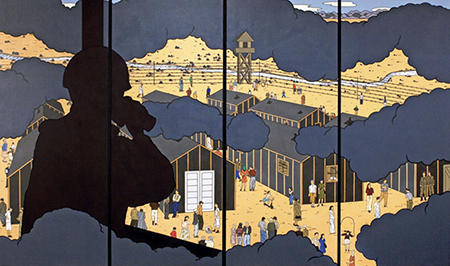
Continuing through August 21, 2022
With the evolution of cultural visibility and political power among racial and ethnic minority groups, the task of revising the art history of the Pacific Northwest is that much more challenging one for critics, curators, and scholars. Whatcom Museum curator Amy Chaloupka has presented a series of group shows addressing this issue, featuring artists from the surrounding region and from farther away (Southwest, California, Idaho, Colorado, etc.). As a Smithsonian Institution affiliate, the Museum has drawn on additional loans for the current reconsideration of “pioneer” history, “Many Wests: Artists Shape an American Idea.” The result is a refreshing, startling, and visually compelling exhibition that contradicts white-settler shibboleths, myths, and outdated notions that have privileged European-American culture over indigenous expressions, or ignored racist indignities suffered by Asian immigrants. Indeed, much of the art is openly accusatory, reminding us of the very different circumstances that revolved around the exploitation and genocide that accompanied the fulfillment of the concept of “manifest destiny,” the slogan every American schoolchild learns about in connection with pre-Civil War westward expansion.
Chaloupka has divided “Many Wests” into four categories: “Caretakers,” “Land Acknowledgment,” “Boundary Breakers,” and “Memory Makers.” These help explain her reasons for grouping particular artists with one another; but we may easily ignore such didactic strategies and stroll through the spacious installation examining differing responses to the once dominant narratives. The “manifest destiny” notion presumed that such expansion and the pillaging and extermination policies that fed that expansion were divinely inspired and a valid move away from, or even against, European (or Russian) plans for colonization or military intercession west of the Mississippi River.
For example, Marie Watt’s embroidered Hudson Bay blanket “Witness (Quamichan Potlatch 1913)” (2015) shows the outlines of a native potlatch, a gathering of tribes to entertain (and intimidate) one another.
In Christina Fernandez’s “Maria’s Great Expedition” (1995-96), the Los Angeles artist reconfigures the status of Mexican-U.S. borderlands, replacing conventional tales of the Alamo or Old California with imagined images of her great-grandmother’s tribulations, with photographs mimicking “Depression-era documentary and mid-century color snapshots.” She fills in the empty spaces where such family histories were omitted or expunged. Similarly, Juan de Dios Mora reminds us in his linocut prints, “Riding the Flying Broom” and “All Decked Out” (both 2010), how much Southwestern ranch culture is indebted to Mexico’s “vaqueros” or cowboys. Borderlines are blurred and re-drawn to expose white land grabs and ownership of cattle. With immigration a current hot-button issue at the U.S.-Mexico border, we are reminded that the entire southern half of what is today Texas was long the property of imperial Spain and republican Mexico, so movement back and forth has long been a given.
Moving to the mid-20th-century, Japanese American artists Wendy Maruyama and Roger Shimomura address the horrific impact of President Franklin D. Roosevelt’s Executive Order 9066 of 1942, which interned all residents of Japanese-ancestry (including Shimomura’s family) within 500 miles of the Pacific coast. Shimomura’s long series, “American Infamy #2” (2006) upends the motif of 15th-century Japanese folding screens to reveal the internment center, Camp Minidoka in Idaho, with an ominous silhouette of a U.S. Army soldier standing guard. For her part, Maruyama piles up thousands of re-created ID tags of the internees at Minidoka.
Preceding the internment camps, Chinese coming to the U.S. faced their own extreme exploitation (as railroad laborers), legislated exclusions, and deportations. The late Hung Liu, trained as a Socialist Realist painter in the People’s Republic of China, created “Mandarin Ducks” (2005), a portrait of Polly Bemis, who married a saloon keeper and was able to “forge her own independence and success as a businesswoman.” Veering away from strictly ideological stylistic markers, Liu’s painting is exhilaratingly brushy, surrounding the legend with good-luck ducks and water lilies.
Latinx and African American artists fare somewhat better, as they incorporated or assimilated into the art world of the American West sooner than did Asians. As a result, their subjects are not as automatically prone to protest or revisionism. In Jacob Lawrence’s painting, “The Builders” (1980), an important work in the artist’s oeuvre, not only are the men working, they are building America, as they built the U.S. Capitol and other significant federal buildings. Lawrence instills an oscillating, dynamic rhythm to the composition, reinforcing the agitated sawing, painting, and constructing. Marita Dingus’ “Green Leaves” (2001) and “Untitled Bowl” (c. 2005) use recycled trash to underscore the ingenuity of enslaved and indentured peoples, who did not always have access to tools or building materials. As Chaloupka notes, they “found ways to repurpose themselves and thrive in a hostile world.”
